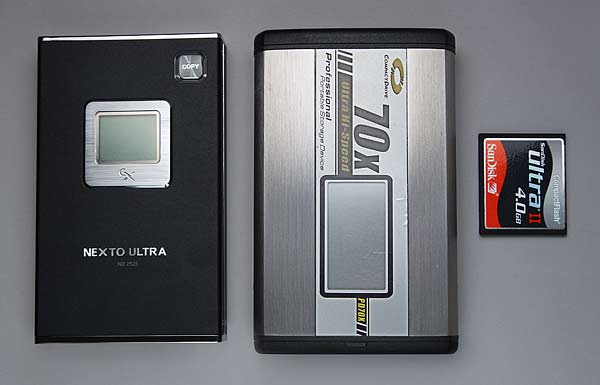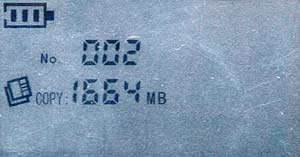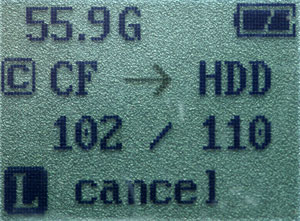| 1: Intro & spec | 2: First impressions | 3: Installing an HDD | 4: User interface | 5: Timings & performance | 6: Compared to | 7: Conclusion |
CompactDrive PD70X portable storage device review
6: Compared to
So, how does the PD70X measure up to the competition?
The closest competitor the CompactDrive PD70X is probably the NextoCF Ultra ND2525. Both are fast standalone portable hard disks, and both only feature a monochrome status display.
There are some significant differences between them though.
External details
The Nexto looks relatively stylish, whilst the PD70X looks almost industrial in design. They're both made of aluminium, but the PD70X feels sturdier due to its thicker aluminium shell. All the ports and controls on the PD70X are neatly protected by two hinged plastic flaps, which means that when you're travelling, there's no way it can be turned on accidentally. That's the good news for the PD70X.
The bad news for the PD70X is that the plastic doors feel flimsy, the battery compartment particularly so.
Here they are side-by-side:
In use
The Nexto scores well here - whilst the PD70X has far more controls, a separate on/off switch and a controller that can be pushed in or rotated up and down, the display only shows a selection of cryptic icons. Working out how to access some functions will definitely require the manual if you have a PD70X, and even some of the simplest functions are not obvious in my opinion.
Here's a shot of the PD70X copying a card:
Batteries
The Nexto has a built-in Lithium polymer battery, and an external Li-ion pack. The PD70X takes, and can charge 4x AA. Personally I prefer the latter approach for travel - if I forget to charge the PD70X, or the charger breaks, I can just pick up some AA batteries.
To be fair, you can buy an external AA battery box for the Nexto, but it's nowhere near as elegant as the PD70X approach in my opinion.
That round goes to the PD70X.
Performance and autonomy
Both comparisons using a Toshiba MK1234GAX, and a 4Gb
Sandisk Ultra II containing 3.77Gb 333 RAW files.
As you can see, the PD70X is nearly half the speed of the ND2525.
So this round goes to the ND2525; the PD70X suffers in autonomy terms because it's slower than the ND2525.
Weight
Note: I've included the case with the Nexto, but omitted it with
the PD70X as I don't think you need it for the PD70X. The PD70X is at
an advantage as the Euro plug it has on the adapter is lighter than a
UK three pin plug.
So, the Nexto wins again.
Compatibility
An issue I've noticed during testing is that the PD70X doesn't get on with 1Gb Type-H xD cards. They work well in the Nexto with a Fujifilm DPC-CF adapter, but the PD70X doesn't read them correctly, either in the xD slot, or via the DPC-CF.
Other than that, the PD70X easily wins this round - in addition to the CF/Microdrive slot both devices have, the PD70X has a slot for reading xD/MemoryStick(Pro)/MMC/SD as well.
Other options?
An option worth considering these days is just buying some more memory cards. If you buy around 100Gb they'll only work out 5x more expensive than a 100Gb standalone PHD at today's prices (15Jul07). A stack of 42 CF cards (7x3x2) is very similar in size to the Nexto, and if you buy 8Gb cards you could actually exceed the storage density quite easily. HDDs are more fragile than cards, and don't handle altitudes well - 3000m/10000ft is your limit usually. Since I don't do much travel above 3000m (except in a pressurized aircraft cabin) the altitude issue doesn't concern me. Fragility does though, which is why I travel with two HDD devices. Travelling with two devices is still cheaper than buying all those cards, and you have two copies of your data in case something bad happens.
6: Compared to
So, how does the PD70X measure up to the competition?
The closest competitor the CompactDrive PD70X is probably the NextoCF Ultra ND2525. Both are fast standalone portable hard disks, and both only feature a monochrome status display.
There are some significant differences between them though.
External details
The Nexto looks relatively stylish, whilst the PD70X looks almost industrial in design. They're both made of aluminium, but the PD70X feels sturdier due to its thicker aluminium shell. All the ports and controls on the PD70X are neatly protected by two hinged plastic flaps, which means that when you're travelling, there's no way it can be turned on accidentally. That's the good news for the PD70X.
The bad news for the PD70X is that the plastic doors feel flimsy, the battery compartment particularly so.
Here they are side-by-side:

In use
The Nexto scores well here - whilst the PD70X has far more controls, a separate on/off switch and a controller that can be pushed in or rotated up and down, the display only shows a selection of cryptic icons. Working out how to access some functions will definitely require the manual if you have a PD70X, and even some of the simplest functions are not obvious in my opinion.
Here's a shot of the PD70X copying a card:


Batteries
The Nexto has a built-in Lithium polymer battery, and an external Li-ion pack. The PD70X takes, and can charge 4x AA. Personally I prefer the latter approach for travel - if I forget to charge the PD70X, or the charger breaks, I can just pick up some AA batteries.
To be fair, you can buy an external AA battery box for the Nexto, but it's nowhere near as elegant as the PD70X approach in my opinion.
That round goes to the PD70X.
Performance and autonomy
| Device | Total time, copy and full verify |
| Nexto CF Ultra ND2525 | 13m 56s |
| CompactDrive PD70X | 24m 50s |
As you can see, the PD70X is nearly half the speed of the ND2525.
So this round goes to the ND2525; the PD70X suffers in autonomy terms because it's slower than the ND2525.
Weight
| Nexto CF Ultra ND2525, full travel spec (UK plug PSU) | 482g |
| Compact Drive PD70X, full travel spec (euro plug PSU) | 574g |
So, the Nexto wins again.
Compatibility
An issue I've noticed during testing is that the PD70X doesn't get on with 1Gb Type-H xD cards. They work well in the Nexto with a Fujifilm DPC-CF adapter, but the PD70X doesn't read them correctly, either in the xD slot, or via the DPC-CF.
Other than that, the PD70X easily wins this round - in addition to the CF/Microdrive slot both devices have, the PD70X has a slot for reading xD/MemoryStick(Pro)/MMC/SD as well.
Other options?
An option worth considering these days is just buying some more memory cards. If you buy around 100Gb they'll only work out 5x more expensive than a 100Gb standalone PHD at today's prices (15Jul07). A stack of 42 CF cards (7x3x2) is very similar in size to the Nexto, and if you buy 8Gb cards you could actually exceed the storage density quite easily. HDDs are more fragile than cards, and don't handle altitudes well - 3000m/10000ft is your limit usually. Since I don't do much travel above 3000m (except in a pressurized aircraft cabin) the altitude issue doesn't concern me. Fragility does though, which is why I travel with two HDD devices. Travelling with two devices is still cheaper than buying all those cards, and you have two copies of your data in case something bad happens.

